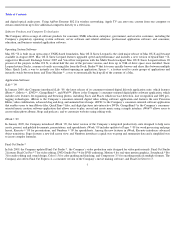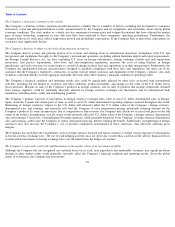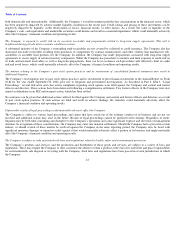Apple 2009 Annual Report Download - page 20
Download and view the complete annual report
Please find page 20 of the 2009 Apple annual report below. You can navigate through the pages in the report by either clicking on the pages listed below, or by using the keyword search tool below to find specific information within the annual report.
Table of Contents
Company’s portable Mac products, iPhones, iPods and most of the Company’
s desktop products. If manufacturing or logistics in these locations
is disrupted for any reason, including natural disasters, information technology system failures, military actions or economic, business, labor,
environmental, public health, or political issues, the Company’s financial condition and operating results could be materially adversely affected.
The Company relies on third-
party digital content and applications, which may not be available to the Company on commercially reasonable
terms or at all.
The Company contracts with certain third parties to offer their digital content and applications through the Company’
s iTunes Store. The
Company pays substantial fees to obtain the rights to audio and video content. The Company’
s licensing arrangements with these third parties
are short-term and do not guarantee the continuation or renewal of these arrangements on reasonable terms, if at all. Some third-
party content
providers currently or in the future may offer competing products and services, and could take action to make it more difficult or impossible for
the Company to license their content in the future. Other content owners, providers or distributors may seek to limit the Company’
s access to, or
increase the total cost of, such content. If the Company is unable to continue to offer a wide variety of content at reasonable prices with
acceptable usage rules, or continue to expand its geographic reach, the Company’
s financial condition and operating results may be materially
adversely affected.
Many third-party content providers require that the Company provide certain digital rights management (“DRM”)
and other security solutions. If
these requirements change, the Company may have to develop or license new technology to provide these solutions. There is no assurance the
Company will be able to develop or license such solutions at a reasonable cost and in a timely manner. In addition, certain countries have passed
or may propose legislation that would force the Company to license its DRM, which could lessen the protection of content and subject it to
piracy and also could affect arrangements with the Company’s content providers.
The Company relies on access to third-party patents and intellectual property, and the Company’
s future results could be materially adversely
affected if it is alleged or found to have infringed intellectual property rights.
Many of the Company’s products are designed to include third-
party intellectual property, and in the future the Company may need to seek or
renew licenses relating to various aspects of its products and business methods. Although the Company believes that, based on past experience
and industry practice, such licenses generally could be obtained on reasonable terms, there is no assurance that the necessary licenses would be
available on acceptable terms or at all.
Because of technological changes in the global personal computer, mobile communication and consumer electronics industries, current extensive
patent coverage, and the rapid issuance of new patents, it is possible that certain components of the Company’
s products and business methods
may unknowingly infringe the patents or other intellectual property rights of third parties. From time to time, the Company has been notified that
it may be infringing such rights. Regardless of merit, responding to such claims can consume significant time and expense. At present, the
Company is vigorously defending more than 47 patent infringement cases, 27 of which were filed during fiscal 2009, and several pending claims
are in various stages of evaluation. In certain cases, the Company may consider the desirability of entering into licensing agreements, although
no assurance can be given that such licenses can be obtained on acceptable terms or that litigation will not occur. If the Company is found to be
infringing such rights, it may be required to pay substantial damages. If there is a temporary or permanent injunction prohibiting the Company
from marketing or selling certain products or a successful claim of infringement against the Company requires it to pay royalties to a third party,
the Company’s financial condition and operating results could be materially adversely affected, regardless of whether it can develop non-
infringing technology. While in management’
s opinion the Company does not have a potential liability for damages or royalties from any known
current legal proceedings or claims related to the infringement of patent or other intellectual property rights that would individually or in the
aggregate materially adversely affect its financial condition and operating results, the results of such legal proceedings cannot be predicted with
certainty. Should
17
























